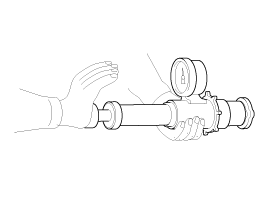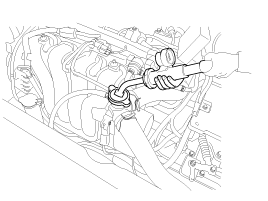 Hyundai Accent: Inspection
Hyundai Accent: Inspection
Radiator Cap Testing
| 1. |
Remove the radiator cap, wet its seal with engine
coolant, then install it on a pressure tester.
|
| 2. |
Apply a pressure of 93.16 ~ 122.58kpa (0.95 ~ 1.25kg/cm²,
13.51 ~ 17.78psi).
|
| 3. |
Check for a drop in pressure.
|
| 4. |
If the pressure drops, replace the cap.
|
Radiator Leakge Test
| 1. |
Wait until engine is cool, then carefully remove
the radiator cap and fill the radiator with engine coolant, then install
it on the pressure tester (A).
|
| 2. |
Apply a pressure tester to the radiator and apply
a pressure of 93.16 ~ 122.58kpa (0.95 ~ 1.25kg/cm², 13.51 ~ 17.78psi).
|
| 3. |
Inspect for engine coolant leaks and a drop in pressure.
|
| 4. |
Remove the tester and reinstall the radiator cap.
|
 Removal and Installation
Removal and Installation
1.
Disconnect the battery terminals. (Refer to Engine
and transaxle assembly in this group)
2.
Remove the air cleaner assembly. (Refer to E ...
See also:
Removal
1.
Turn ignition switch OFF.
2.
Remove the crash pad lower panel.
(Refer to the Body group - "Crash pad")
...
Removal
1.
Remove the following items;
A.
Engine cover (A).
B.
Air cleaner assembly and air duct (B).
...
Installation
PODS-F ECU
1.
Install the PODS-F ECU equipped seat track assembly.
(Refer to the Body group - "Seat")
2.
Install the ...
Hyundai Accent Manuals
В© 2011-2025 Copyright www.hamanual.com



